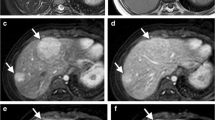Abstract
Gadoxetate disodium (Gd-EOB-DTPA) is a relatively new hepatobiliary MRI contrast agent. It is increasingly used in adults to characterize hepatic masses, but there is little published describing its use in children. The purpose of this paper is to describe our pediatric MRI protocol as well as the imaging appearance of pediatric liver lesions using gadoxetate disodium. As a hepatocyte-specific MRI contrast agent, Gd-EOB-DTPA has the potential to improve characterization and provide a more specific diagnosis of pediatric liver masses.











Similar content being viewed by others
References
Ringe KI, Husarik DB, Sirlin CB et al (2010) Gadoxetate disodium-enhanced MRI of the liver: part 1, protocol optimization and lesion appearance in the noncirrhotic liver. AJR 195:13–28
Cruite I, Schroeder M, Merkle EM et al (2010) Gadoxetate disodium-enhanced MRI of the liver: part 2, protocol optimization and lesion appearance in the cirrhotic liver. AJR 195:29–41
Joyner BL Jr, Levin TL, Goyal RK et al (2005) Focal nodular hyperplasia of the liver: a sequela of tumor therapy. Pediatr Radiol 35:1234–1239
Towbin AJ, Luo GG, Yin H et al (2010) Focal nodular hyperplasia in children, adolescents, and young adults. Pediatr Radiol 41:341–349
Vasanawala S (2010) MRI of the liver—how to do it. Pediatr Radiol 40:431–437
Marrone G, Maggiore G, Carollo V et al (2011) Biliary cystadenoma with bile duct communication depicted on liver-specific contrast agent-enhanced MRI in a child. Pediatr Radiol 41:121–124
Raman S, Leary C, Bluemke D et al (2010) Improved characterization of focal liver lesions with liver-specific gadoxetic acid disodium-enhanced magnetic resonance imaging: a multicenter phase 2 clinical trial. J Comput Assist Tomogr 34:163–172
Reimer P, Rummeny EJ, Shamsi K et al (1996) Phase II clinical evaluation of Gd-EOB-DTPA: dose, safety aspects, and pulse sequence. Radiology 199:177–183
Jimenez RM, Connolly S, Blickman JG (2008) Accessory organs of digestion. In: Devos AS, Blickman JG (eds) Radiologic imaging of the digestive tract in infants and children. Springer, New York, pp 133–165
Das CJ, Dhingra S, Gupta AK et al (2009) Imaging of paediatric liver tumours with pathological correlation. Clin Radiol 64:1015–1025
Imbach P (2006) Hepatic tumors. In: Imbach P, Kuhne T, Arceci RJ (eds) Pediatric oncology: a comprehensive guide. Springer, New York, pp 187–191
Prokurat A, Kluge P, Kosciesza A et al (2002) Transitional liver cell tumors (TLCT) in older children and adolescents: a novel group of aggressive hepatic tumors expressing beta-catenin. Med Pediatr Oncol 39:510–518
Moore CW, Lowe LH (2008) Hepatic tumors and tumor-like conditions. In: Slovis TL (ed) Caffey’s pediatric radiology, 11th edn. Mosby, Philadelphia, pp 1929–1948
Crider MH, Hoggard E, Manivel JC (2009) Undifferentiated (embryonal) sarcoma of the liver. Radiographics 29:1665–1668
Kim M, Tireno B, Slanetz PJ (2008) Undifferentiated embryonal sarcoma of the liver. AJR 190:W261–W262
Braga L, Armao D, Semelka RC (2006) Liver. In: Semelka RC (ed) Abdominal-pelvic MRI, 2nd edn. Wiley, Hoboken, pp 47–447
Chung EM, Cube R, Lewis RB et al (2010) From the archives of the AFIP. Pediatric liver masses: radiologic-pathologic correlation part 1. Benign tumors. Radiographics 30:801–826
Christison-Lagay ER, Burrows PE, Alomari A et al (2007) Hepatic hemangiomas: subtype classification and development of a clinical practice algorithm and registry. J Pediatr Surg 42:62–67
Goshima S, Kanematsu M, Watanabe H et al (2010) Hepatic hemangioma and metastasis: differentiation with gadoxetate disodium-enhanced 3-T MRI. AJR 195:941–946
Karam AR, Shankar S, Surapaneni P et al (2010) Focal nodular hyperplasia: central scar enhancement pattern using gadoxetate disodium. J Magn Reson Imaging 32:341–344
Zech CJ, Herrmann KA, Reiser MF et al (2007) MR imaging in patients with suspected liver metastases: value of liver-specific contrast agent Gd-EOB-DTPA. Magn Reson Med Sci 6:43–52
Author information
Authors and Affiliations
Corresponding author
Rights and permissions
About this article
Cite this article
Meyers, A.B., Towbin, A.J., Serai, S. et al. Characterization of pediatric liver lesions with gadoxetate disodium. Pediatr Radiol 41, 1183–1197 (2011). https://doi.org/10.1007/s00247-011-2148-6
Received:
Revised:
Accepted:
Published:
Issue Date:
DOI: https://doi.org/10.1007/s00247-011-2148-6




